|
ALASKA NATIVE GAMES: A RESOURCE
GUIDE
In addition to the games listed for WEIO, AWG, and NYO, the author
would like to expand on and include games played by various Native
people in Alaska. The games may have been played in the past, by one
or more Native groups, and in various forms. However, the literature
generally gives credit for invention to a particular Native group.
This inventory of games is not complete, but it does give the reader
some additional knowledge and information about games played by
various Native groups. The purpose of this Resource Guide is to
provide educators or other interested individuals activities that can
be easily included and implemented within the school or recreational
setting. The Native groups presented and discussed include, the
Athabaskans, Eskimos (Inupiat and Yupik), Aleuts, Tlingits, Eyaks,
and Haidas. The map below shows the location of the each Native
group.
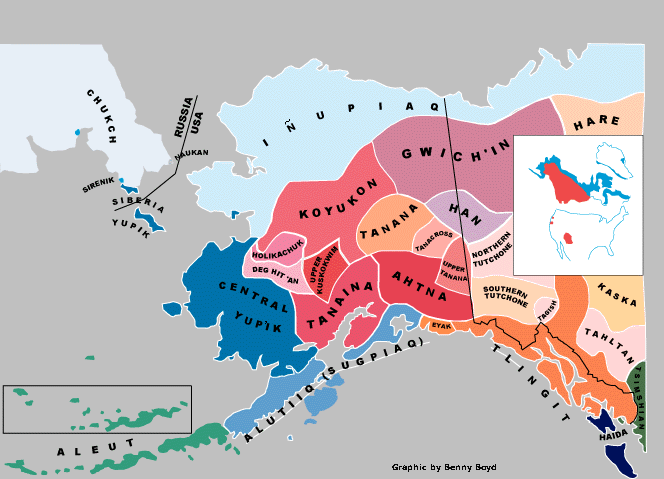
ATHABASKANS
1. SIT DOWN TUG OF WAR (Fork Yukon Young People) 
Materials- Two stout sticks about three inches long
attached to each other with a short length of rope.
Players- Two at a time.
Procedures- Two players sit on the floor or ground facing each
other. They put the soles of their feet against each other. Each
person holds one of the sticks firmly in both hands. They pull
against each other until one is pulled up.
2. CARIBOU EYES (Fork Yukon Young People and Walsh)
Materials- None.
Players- Five or more.
Procedures- The group clasps hands and forms a circle around
one player who is "it". "It" would place his hands on each of the
other players and ask who he was. The answer is always the name of
an animal. "It" would then try to break out of the circle by
stepping on the toes of his captors, who would jump nimbly to
avoid this. If "it" succeeded in breaking free, everyone would run
after him.
3. DODGE BALL (Fork Yukon Young People and Walsh)
Materials- One small caribou (or moose) skin ball. Five
inch hole in the dirt.
Players- Any number.
Procedures- Each player tries to throw the ball into the hole
from five or six yards away. If a player makes it, he runs to the
hole and gets the ball. All the other players run away. The one
with the ball throws it at one of the players running away. If the
ball hits one of these players, the one who threw it gets to spank
the one the ball hits.
Variation: A large circle is made. Each player digs a small
hole in the circumference. One player has a ball. He tries to roll
it into one of the other player's hole. The person whose hole the
ball rolls into, grabs the ball and throws it at the other players
who run away. If a player is hit, he must put a pebble in the hole
of the person who threw the ball. If no player is hit, every one
runs after the person who threw the ball and if they catch him,
they get to spank him.
4. MOOSE SKIN DRAG (Fork Yukon Young People)
Materials- Piece of moose skin. Sharpened stick for each
of the players.
Players- Two to eight.
Procedures- Boys try their skill at dragging a moose skin along
the ground while their cohorts chase after them with sharpened
sticks trying to pin the skin to the ground, thus stopping the one
who pulls it. If the boy pulling the skin gets away, he is
considered very smart.
5. BROADJUMP HOP (Fork Yukon Young People and Walsh)
Materials- One short pointed stick for each player.
Players- Any number.
Procedures- A player grabs a stick in his hand. Starting from a
particular place, he jumps landing on both feet. He then jumps
again landing on one foot. His other foot must not touch the
ground. He then hops forward landing on the same foot. He then
reaches as far forward as he can and stabs his stick into the
ground being careful not to lose his balance or to touch his other
foot to the ground. Each player does this in turn. In the next
go-around, the player leaves his stick in the ground until he
completes his last hop. He then picks up his stick and moves it
ahead, if he thinks he can reach further than before.
ESKIMOS (INUPIAT and YUPIK)
INUPIAT
1. MAKPIGAMIMAIT (POLE PUSH) (Eger)
Materials- Wooden stick.
Players- Two players.
Procedures- Players lie down on their backs with their feet
raised to hold a wooden stick between their feet. One player puts
his feet in the center of the stick while the other player
separates his feet one on each side of the stick. The object is to
push the other player over by pushing very hard with one's feet
against the stick.
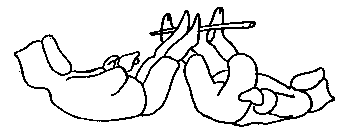
2. RABBIT JUMP #2 (Walsh)
Materials- None.
Players- Any number.
Procedures- A player would jump as far as he could with both
feet. Next he would jump with one foot. Next he jumped again with
both feet, but landed on both hands without touching the ground
with his feet. Then he jumps once more and lands with both
feet.
3. TOE JUMP (Bless and Walker)
Materials- None.
Players- Any number.
Procedures- Player stands behind a line, grabbing his toes.
Knees must be bent. The player jumps forward as far as he can
without letting toes go and maintaining balance. Record the
distance from the line.
4. SEAL SKIN SKIPPING (Bless and Walker)
Materials- Rope and seal skin ball. Tie seal skin ball in
the middle of the rope.
Players- Groups of three players.
Procedures- Two players hold the ends of the rope while the
third player places himself facing the seal ball. He jumps over
the rope. After each successful jump, the player's body must
rotate and must be facing the seal ball. The winner is the one who
completes the most successful jumps.
5. PEED LE TA TUQ (Eger)
Materials- None.
Players- Any number.
Procedures- A player moves from a kneeling position to squat
with a quick jump and then back to kneeling again. The contest
continues in this cyclical manner until only one player is able to
continue.
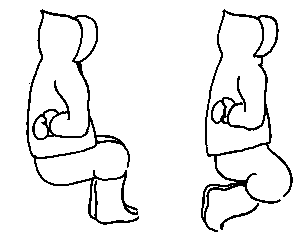
YUPIK
1. ANGKALUTN (KEEP AWAY) (Ager)
Materials- A ball.
Players- Any number from three on up.
Procedures- A ball is used as the object which one team
attempts to toss back and forth to each other without letting any
member of the opposite team catch it. If a member of the opposite
team succeeds in catching the ball, the teams switch roles. No
score is kept and there are no readily apparent field lines or
boundaries.
2. CHUKI-CHUKI (Ager)
Materials- None.
Players- Even number of players.
Procedures- This is a rhyming game which also involves physical
coordination. A pair holds hands facing each other and chant
"chu-ki, e-mak-o-chuk, ta--le-o-chuk." At the same time, they move
their linked arms in a prescribed pattern. To the first four
syllables (chuki, chuki) the first player pushes his right arm
forward, so that the second player's left arm goes back, and at
the same time pulls his left arm back, bringing the seconds
player's right arm forward. This is done 4 times. To emakochuk,
one pair of arms is crossed over the other, and to talleochuk, the
second pair of arms is crossed over the first. The players attempt
to do this faster and faster, testing both verbal fluency and
physical coordination.
3. ANAYUMIAK (BALL OVER THE ROOF) (Ager)
Materials- A ball.
Players- Seven and up (two teams).
Procedures- Two teams place themselves on opposite sides of a
cache (or any building). The first team throws a ball over the
roof to the opposite team, who catch it and run around the
building to throw the ball at members of the first team in an
attempt to hit one of them. Any player who is hit must then join
the team which hit him. The teams continue to play until they are
tired or until all members of one team have been taken by the
opposite team.
4. ESKIMO SOLITAIRE (Ager)
Materials- Deck of cards (minus the jokers).
Players- One.
Procedures- The entire deck is laid out in 13 stacks of 4 cards
each. The last card to be put down is turned face up and placed at
the bottom of the stack with which it corresponds. That is, the
first stack is for Aces, the seconds for 2's, the 3rd for 3's and
the last for kings. If, for example the last card put down is a 7,
it will be placed face up at the bottom of the seventh stack of
cards. Then the top card of the seventh stack is turned up and
placed at the bottom of its corresponding stack. If it is a jack,
for example, it is placed face up at the bottom of the eleventh
stack. This sorting process continues until all cards are in
appropriate stacks. In order to really win this game, a player
must finish with the kings, that is, the final card to be turned
over must be a king.
5. SQUIRREL AND DOG (Ager)
Materials- None.
Players- Groups of three with two additional players.
Procedures- This is a tag game. All but two players are divided
into groups of three. Two hold hands and are the "trees" while the
third one stands between them and is a squirrel. The dog chases
the squirrel until the squirrel runs to two trees where he is
safe. The squirrel who is already there must leave and be chased
by the dog. If the squirrel is caught by the dog - the squirrel
then becomes the dog.
ALEUTS
1. QUOITS GAME #2 (Walsh and Some Alaska games and how to play
them)
Materials- Green cloth mat, wooden rings, and counters.
Players- Two players or two teams.
Procedures- A green cloth mat with a colored stripe represents
the mat. (Traditionally a sealskin was used for a mat). Players
tossed wooden rings toward the strip while sitting or squatting on
the ground. Points were scored for those rings which landed
closest to the stripe.
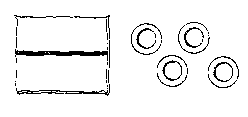
2. STONES (Some Alaska games and how to play them)
Materials- Four small smooth stones.
Players- Any number.
Procedures- Toss all four stones into the air with one hand and
catch them with the same hand before they hit the ground. The
winner is the one who catches all four stones.
3. STICK AND BOARD GAME (Walsh and Some Alaska games and how to
play them)
Materials- A thin, flat wooden board with holes carved
through it, string, and wooden stick.
Players- Any number.
Procedures- Hold the stick, swing the board upwards and aim for
a hole. The object is to spear one of the holes with the
stick.
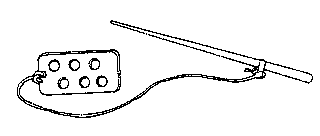
4. THROWING DISKS #1 (Walsh)
Materials- Two platforms, two otter skins, ten disks and
two markers.
Players- Two to four players.
Procedures To set up the platform, a quarter inch piece of
plywood is needed. The length of the platform should be about
twenty inches and the width about sixteen inches. One end should
be raised off the floor about five inches, and the other end is
raised only about one and a half inches off the floor so that the
platform is slanted. A tanned otter fur is placed on top of the
platform. Then a marker, about the size of a half dollar, is
placed in the center of the platform. This marker is made out of
copper or anything that will stand out on the otter skin. The
disks, which are tossed by the players, can be made either from
moose or caribou antlers. Each disk should be a quarter inch thick
and the size of a half dollar. The disks should be marked to
distinguish the players. A small "x" is placed on five disks and
the other five disks are marked with a larger "x" or each set can
be colored differently to distinguish them. To play the game the
platforms are placed on the floor twelve feet apart with the lower
end facing each player. Then the otter skins are placed on the
platform with the markers in the center. Then the players,
kneeling on the right sides of the platform choose a set of disks,
and crouched on one knee, they toss the disks aiming for the
markers opposite them. The object of the game is to score ten
points before the opponents. Three points are scored when a disk
lands on the marker, two points are scored when the disk is
touching the maker, and one point is given for the disk that is
closest to the marker. Also a point can be scored it it's the only
disk on the platform.
TLINGITS
1. JACKSTRAWS (Walsh)
Materials- Bunch of slender sticks and a wooden hook for
each player.
Players- Any number.
Procedures- The player grasps the bunch of sticks between the
thumb and the forefinger of his right hand, resting one end upon
the floor; then he suddenly releases them and they fall in a small
heap. The players have a small wooden hook, and each in succession
removes as many of the sticks as he can without moving any but the
one taken. Each player keeps those he succeeds in removing, and
the one holding the largest number at the end is the winner.
2. IVORY AND WOODEN DICE GAME (Some Alaska games and how to play
them, Walsh, and Culin)
Materials- Chair-shaped wooden or ivory dice and 20
sticks as counters.
Players- Two players.
Procedures- The players hold the back of the "chair" and
flipped it. Each player starts the game with 10 counters, the
first player to get 20 counters wins the game. If the chair lands
sitting up on the shortest edge the score is two. One point if it
lands on one of the other three edges. When the dice falls on
either side, the score is zero and the player misses his turn,
which passes to his opponent. As one scores, the player takes one
or two counters from his opponent's pile and adds them to his own.
When it lands on its bottom, the player wins the game or if one
player takes all the counters.

3. BONES FOR A HAND GAME (Culin)
Materials- Four Bones.
Players- Any number.
Procedures- A gambling game and part of the paraphernalia of a
shaman.

4. GAMBLING STICKS (Some Alaska games and how to play them)
Materials- Gambling sticks with at least one devilfish or
octopus call naq.
Players- Two players or any number.
Procedures- There are many ways to play with the sticks. One
way is for two players sit opposite each other with the naq pulled
from the set. One player picks three sticks and mixes the naq and
the three sticks together between burlap or cedar bark. Without
looking, the sticks, are divided into two piles (two sticks per
pile). The player who did not mix the sticks guesses which pile
contains the naq. A second way is for seven sticks to be pulled
from the set and hidden under the cloth or cedar bark. A third way
is with any number of players. One player shuffles the sticks
under the cloth. Then the sticks are rolled into a long piece of
material. Each player then bets on which stick he thinks the
dealer will pull out first. All chant the name of the stick.
5. CHESSMAN (Culin)
Materials- Twenty-two carved wooden chessmen.
Players- Two players.
Procedures- A game of chess was played with the twenty-two
carved wooden chessmen.
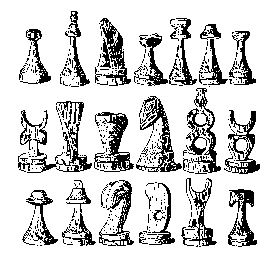
EYAKS
1. STICK GAME (Birket-Smith and DeLaguna)
Materials- Two cylindrical sticks for each player which
are small enough to be concealed in the hand. One stick in the set
is marked with a bit of thong tied about the middle.
Players- Two teams consisting of six to fourteen players.
Procedures- The players holding the sticks would shuffle them
about for a short time, their hands hidden behind their backs.
Then all would hold their hands out before them, the palms closed,
and one player from the opposing team would try to guess which
hand held the marked stick. At the end of the guessing the sticks
were passed to the opposite team. Small sticks, used as counters,
were placed on the ground between the two teams. The number used
depended on how long they wanted to play. If the guesser had
correctly designated the hand in which the marked stick was
hidden, the player holding it had to drop out. If the guesser
failed, his opponents took one counter from the pile in the
middle. After all the members of one team had been forced to drop
out, their opponents took all the counters. A team had to win all
the counters from their opponents and from the pile in the middle
to win the game.
2. WOODEN DICE GAME (Some Alaska games and how to play them and
Birket-Smith and DeLaguna)
Materials- Chair-shaped wooden dice.
Players- Any number.
Procedures- The players hold the back of the "chair" and flip
it. Each player starts the game with 10 counters, the first player
to get 20 counters wins the game. When the dice falls on its die,
the score is zero. When it lands on its bottom, the player wins
the game.

3. PARTNER GAME (Birket-Smith and DeLaguna)
Materials- A small shaving which was placed on a seal
skin in the middle of the room. Wooden disks, two to four inches
in diameter.
Players- Two pairs of partners.
Procedures- Two players sit facing each other at opposite ends
of the room, the partners being divided. In turn they toss wooden
disks at the shaving. The player beside the tosser watched him to
prevent cheating. Points were counted according to the relative
nearness of the disks thrown to the shaving. This is a gambling
game.
4. SHINNY (Birket-Smith and DeLaguna)
Materials- Skinny sticks are naturally curved pieces of
wood. A ball is a roughly rounded wooden block.
Players- Two teams evenly matched and containing any number of
players.
Procedures- This game is played on the beach. The ball is
buried in the sand. Two players, one from each team, dig up the
ball with their sticks. The teams then try to drive the ball
across their opponent's goal line. The field is about two or three
hundred years long. There are no rules, but it is considered wrong
to hit an opponent intentionally.
5. WRESTLING (Birket-Smith and DeLaguna)
Materials- None needed.
Players- Two or more groups of players.
Procedures- One form of wrestling is for two players to grab
each other and try to throw each other to the ground. A second
form would be to lock their middle fingers together, each
struggling to straighten out the fingers of his opponent. A third
form is for two players to sit on the ground with their feet
braced together and try to pull each other over forward with their
arms.
HAIDAS
1. STICK GAME #2 (Culin)
Materials- Forty or fifty round stick (pins) or pieces of
wood, five inches long by one-eighth of an inch thick, painted in
black and blue rings and polished. There is also one stick
entirely colored and one entirely plain. Cedar bark and a mat.
Players- Any number.
Procedures- Each player has a bunch of sticks (forty or fifty)
and selects one stick (entirely colored or entirely plain). The
player then takes a handful of these sticks and putting them under
a quantity of finely separated cedar bark, which is as fine as tow
and kept constantly near him, he divides the sticks into two
parcels, which he wraps up in the bark, and passes them rapidly
from hand to hand under the tow, and finally moves them round on
the ground or mat on which the players are always seated, still
wrapped in the fine bark, but not covered by the tow. His opponent
watches every move that is made from the very first with the
eagerness of a cat, and finally, by a motion of his finger,
indicates which of the parcels the winning stick is in. The
player, upon such indication, shakes the sticks out of the bark,
and with much display and skill, throws them one by one into the
space between the players till the piece wanted is reached, or
else, if it is not there, to show that the game is his. The winner
takes one or more sticks from his opponent's pile, and the game is
decided when one wins all the sticks of the other.
2. KWAI INDAO (Culin)
Materials- A set of forty or fifty sticks, representing
ten different numbers.
Players- Any number.
Procedures- The set of forty or fifty sticks are placed in a
row. The blindfolded players alternately try to repeat from
memory, the order in which then ten numbers run.
3. HAL HAI JAO (TURN AROUND GAME) (Culin)
Materials- Twenty or forty small sticks, six inches long.
Players- Any number of groups of two.
Procedures- The twenty or forty small sticks are taken in the
palm, thrown up in the air, and caught on back of the hand. They
are then thrown up again, if any are caught, and if possible an
odd number caught in the palm. If an odd number - one, three,
five, or seven - is caught, one stick is kept by the player, who
tries again. If none or an even number is caught, the opposite
player takes his turn. He who takes the last stick wins all his
opponent's sticks and takes them all up and goes on as before.
4. HLKETOSGAN (JACKSTRAWS) (Culin)
Materials- Fifty to seventy-five small squared wooden
splints about four inches long and a little larger than a match.
Players- Any number.
Procedures- The bundle of wooden splints are placed in a small
pile crosswise on the back of the player's outstretched right
hand. The player then removes his hand quickly and tries to grasp
the falling sticks between his thumb and fingers, keeping his palm
downward. If one or more of the sticks fall to the ground it is a
miss and the next player tries. Every time a player succeeds in
catching all of the falling sticks, he lays aside one of them as a
counter until all are gone. Then each player counts up and the one
holding the greatest number is the winner.
5. STICK GAME OF EVEN OR ODD (Culin)
Materials- Forty or fifty round pins or pieces of wood,
five inches long by one-eighth of an inch thick, painted in black
and blue rings and polished.
Players- Two players.
Procedures- Players spread a mat made of inner bark of the
yellow cypress, on the ground. One player selecting a number of
these pins, covers them up in a heap of bark cut into the fine
fiberlike tow. Under cover of the bark he then divides the pins
into two parcels, having taken them out, passes them several times
from his right hand to his left, or the contrary. While the player
shuffles he repeats the words i-e-ly-yah to a low, monotonous
chant or moan. The moment he finishes the incantation his
opponent, who has been silently watching him, chooses the parcel
where he thinks the luck lies for odd or even. After which the
second player takes his innings with his own pins and the same
ceremonies. This goes on until one or the other loses all his
pins.
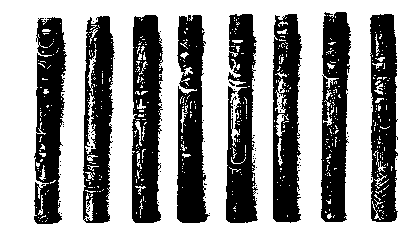
One must continue to remember that there are many ways in which
the process of creating opportunities for students to learn in
society can occur. There is no best way for ALL children to learn.
Our young people are a resource, not just recipients of programs.
Through cooperation and coordination, decision-making can become a
shared community-school team process. This autonomous team can also
share in the development of a mission statement or vision, goals,
designs for how to reach these goals, and ways to monitor achievement
in these goals. One must foster learning by fostering relationships.
This may take "a very special kind of listening, listening that
requires not only open eyes and ears, but open hearts and minds"
(Delpit, 1995). Native games can be the threads that mesh learning
situations into the fabric of life. The interconnection of the games
with real life situations becomes the true definition of holistic
learning. Together, we can become a "community of inquirers" (Fine,
1995) promoting alternative life choices for ALL students, and
working collectively to speak out, be heard, and effect change.
|